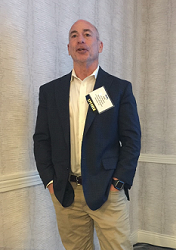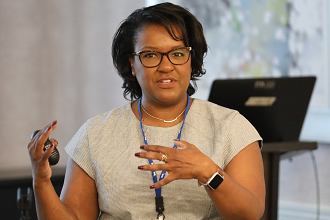Exploring a New Area of Knowledge at This Year’s Forum
Attendees at this year’s Valve Industry Knowledge Forum received a fresh dose of education on a subject not previously covered at VMA meetings: marketing and management.
#VMAnews
EMPLOYMENT LEGALITIES
Among the variety of speakers featured in the marketing and management track was Jack Wisdom, a partner in the law firm of Martin, Disiere, Jefferson & Wisdom. Wisdom spoke to attendees about non-disclosure and non-compete agreements in his presentation “Guide to Battle Ready Restrictive Covenants.”
Several types of agreements fall under the arc of PERC including: non-compete, non-disclosure, non-solicitation, non-hire, anti-raiding/anti-piracy, forfeiture for competition and fee for competition. Also, when it comes to these contracts, “one size does not fit all,” Wisdom said. They are location specific, industry specific, and activity (role) specific. Wisdom reminded attendees that while these types of contracts can be awkward and may sometimes seem unreasonable, they are there to protect the relationship between employer and employee. For the good of the company and to avoid unnecessary legal battles, PERC should be put into place as a part of the hiring process, he said. Additionally, Wisdom noted it’s a good practice to remind an employee of these agreements after they leave the company.
SUPPLY ISSUES AND TRENDS
Meredith Moot, a principal with Korn Ferry, spoke to attendees on “Navigating the Future of Logistics & Supply Chain.” Upcoming trends in this area revolve around the “ultra tech-enablement,” such as the Industrial Internet of Things and analytics, autonomous vehicles and mobile robots, and more. Trends also revolved around consumer and stakeholder expectations” such as transparency and traceability, sustainability and regulatory compliance; and around what’s called the “future of work,” which are developments such as crowdsourcing, flexibility, mobility and connectivity, and diversity in people and industry.
Solving workforce issues is critical for managing cost and improving service and productivity, Moot said, with the top five workforce issues being attracting talent, developing leaders, retaining high performers, enhancing employee motivation and engagement, and enhancing workforce performance. Additionally, Moot noted that technology is changing the workforce down to the makeup and talent strategies of an organization. Job skills are evolving and tech is challenging compensation models; companies are innovating and incorporating value-added services to increase the scope of home delivery, to customize and personalize, and to enable seamless return logistics.
FINANCIAL ISSUES
Chief Financial Officer of Setpoint Integrated Solutions Matt Bate shared with attendees his ideas on “Finances for the Non-finance Manager.” Through his discussion of investor perspectives, financial value and risk, key terms and ratios, and practical applications, Bate provided a framework for those without financial backgrounds to make finance decisions. Companies have investment options, Bate said, and they need to evaluate how to further invest cash within the business, such as controlling inventory, accounts receivables or operating expenses. Many risks exist, however, from economic or credit risk to competition and legal issues.
Bate noted that a higher risk should always equal a higher reward, and when that isn’t the case, the risk likely isn’t worth taking. Bate covered common terms and ratios to know such as working capital, capex, EBIT/operating profit, and weighted average cost of capital. After presenting the basics of financial value, investments and risks, Bate offered practical applications for profit and loss management and pricing, such as early payment discounts, extension of credit terms, and addition to inventory stock levels.
WORKING WITH PARTNERS
Andrew Fitzgerald, senior director of Business Intelligence for the Baton Rouge Area Chamber, discussed “Economic Developers as Industry Partners.” His presentation highlighted the importance of regional and state economic development groups, who are allies to manufacturers and other industries when it comes to business climate and customer base growth. For example, chambers of commerce strive to create and maintain favorable business climates in their regions, to ensure educational opportunity, and to create a solid workforce pipeline. For a manufacturer, partnering with the local chamber is beneficial not only for expanding business, but for ensuring jobs down the road, creating customized training programs, and taking advantage of incentives such as competitive tax rates, etc.
DELIVERING ON TIME
In his presentation, “Achieving High On-Time Delivery in Valve Manufacturing,” Michael Babineau, president of Celero Optima, covered challenges in manufacturing methodology, what concepts apply on delivery and their benefits, and how to implement needed changes. The world of valve manufacturers is characterized by a large variety of SKUs, high variability in customer demand, much variability in supplier base, a complex internal network, high variability in internal operations, and shrinking product lifecycles with increasing product customization.
These complexities and variabilities create many challenges such as inconsistent delivery performance, high inventory, too much expediting and low productivity. Babineau explained that flow can be maximized through concepts such as the Theory of Constraints and Just-In-Time Material Release. “Shop floor workers can’t work on the wrong jobs if those jobs haven’t been released,” Babineau noted. Implementing new concepts takes management buy-in and commitment, training across the affected departments, adapted information systems, and metrics tracking to guide actions, he said. He advised implementing the changes with the workers then expecting some bumps in the road. However, with these changes put into place, manufacturers can deliver on time consistently even with internal and external unpredictability that comes with the industry.
SOCIAL MEDIA AND THE WEB
Kelly Watson, CEO and Joshua Songer, chief strategist of Project1421, brought their expertise in the ever-expanding worlds of social media to attendees through their presentation, “Social Media Tools & Trends for B2B Enterprises.”
Their talk began with the basics of selecting which social media networks to use. LinkedIn is currently the social network for business and essential for the hiring process, they said. LinkedIn also fosters an ongoing relationship with people (i.e. customers and potential hires). Facebook isn’t as good for B2B, but can be a great tool for communicating with employees, their families and a broader consumer audience. Instagram provides a massive reach and engagement with the younger demographics. It’s also a powerful tool to show the business behind the scenes, they said, but posts need to be inspirational and non-promotional; otherwise, they come across as inauthentic.
Once social networks are established, it’s essential to create a social media toolkit so that people handling social media have guidelines. There are publishing tools that can be used to streamline social media such as HootSuite, Sprout Social, Hey Orca, and Buffer. Watson and Songer also spoke about the importance of listening to social media: monitoring conversations about the company’s brand, product or market.
The “hot thing” in social media these days is employee advocacy, the presenters said, noting that the cumulative audience of a company’s employees can be a lot larger than the direct audience of the enterprise. Reporting is another essential aspect, an aspect that includes key performance indicators (KPIs), leading options, competitive analysis, frequency and acting on data. The speakers touched on upcoming social media trends, such as video (which is perceived as more trustworthy) and user-generated tools (which allow the audience to follow conversations and engage). Watson and Songer also offered additional tips for capitalizing social media presence such as: trimming down the website and using it to drive messages to social media, inviting employees to engage on social media (their “likes” are essentially endorsements for the company), and when employees are resistant to using social media, bringing in an outside consultant to educate them on its importance.
Nomah Zia, director of Digital Customer Experience for Emerson Automation Solutions – Final Control, presented “Websites Done Right” to strengthen attendees’ knowledge of digital best practices and show them how to create a website that delivers better business results. Zia emphasized the “3C Rule” – code, create, communicate. Code is the foundation of every site and must be structured correctly to achieve optimal search rankings: always tag titles and web copy and use fluid or responsive layout, Zia said. A domain should be memorable and credible with a design that is clean and simple. Zia suggested hiring a reputable hosting company for the platform, and looking for enhanced features such as internal search, multimedia hosting or traffic reporting to get the most out of this paid service. A website is a company’s identity and often a first impression for customers, so while typography and fonts may seem like an afterthought, it’s important to use standard web safe fonts to avoid glitches on the user end. Zia emphasized that content should be formatted for findability, dynamic to engage visitors, and that brand connection be made throughout the site.
CUSTOMERS AND EMPLOYEES
Jeff Carmody of Wolseley Industrial Group spoke on, “Wholesale Distribution: Connecting the Customer with Quality Manufacturers.” From manufacturer to distributor to end user, distribution in the U.S. manufacturing industry is a complex process, he said. Manufacturers select suppliers based on location, technical expertise, inventory and strength of the distributor, among other considerations. While there are many challenges and opportunities when it comes to managing these resources – including a changing landscape due to evolving technology – end users will continue to search for the right partners to supply their facilities, he noted.
, performance specialist with Insperity, delivered a presentation on “Effective Interactions Using Extended DISC.” DISC is a personal assessment tool that classifies a person’s work style as Dominant, Influencing, Steady, or Conscientious. Dominant or D-styles are direct, competitive, and create change with independent decisions. Conscientious or C-styles are compliant, analytical and detail oriented. These people are most comfortable working alone and are focused on the task at hand. Steady or S-styles are laid back, reliable and eager to help others. They enjoy working in team environments and tend to resist change. Influencing or I-styles are outgoing, optimistic, and can be impulsive. Social acceptance is important to them.
No matter the style, each has its own strengths but there is risk of the “Too” factor: too dominant, too analytical, etc., Blaney said. By assessing employees’ DISC styles, the employer can better understand how to work and communicate with each employee while allowing employees to understand their behavioral style and that of their coworkers. In turn, when employees understand their own style, they have the opportunity to adjust how they behave in the workplace.
What factors are in play behind the scenes when it comes to your customers buying process? Ron Merrick, Senior Fellow at Flour Enterprises explored this question with his presentation, “Making the Decision to Specify or Buy Your Product: End-User Perspective.” While low price seems like the obvious way to gain a customer, many factors influence purchasing decisions, such as technicality, reliability, sustainability, and manufacturing efficiency.
The manufacturer-customer relationship doesn’t end after the sale is closed. David Bayreuther of Metso Flow Control USA, Inc. spoke to attendees about “Keeping Customers Happy: After Sales Service.” Bayreuther will provide a summarization of his presentation in a future article for VALVE Magazine.
RELATED CONTENT
-
Check Valves: The Most Important Valves in Your Process System
Check valves, as critical as they are for flow system performance, often don’t receive the respect they are due, said Arie Bregman, vice president and general manager, DFT, Inc., in a recent VMA presentation.
-
An Interview with VMA's New Board Chairman
At VMA’s 83rd Annual Meeting, Ron Warren, President and COO of Bray International Inc., was elected the board chairman of VMA for the next year.
-
ValvTechnologies and Severn Form Strategic Partnership
ValvTechnologies and Severn Glocon have reached a partnership agreement that will see collaboration between two of the world’s leading engineering and manufacturing companies specializing in innovative, high-end, severe-service valves.












 Unloading large gate valve.jpg;maxWidth=214)